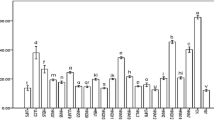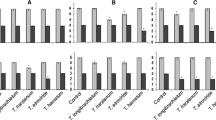Abstract
Potato late blight, caused by Phytophthora infestans is a most destructive plant pathogen and can lead to serious economic losses in potato. Some strains of the Trichoderma genus can act as potential biocontrol agents and are able to control many plant disease in crops. The present study was carried out to screen effective Trichoderma isolates against P. infestans and to study the potential modes of action involved. In vitro bioassays between P. infestans and Trichoderma isolates demonstrated that the P. infestans colony was significantly inhibited and overgrown by Trichoderma isolates. Antifungal metabolites produced by the isolate HNA14 significantly prevented the linear growth of the P. infestans colony. Mycoparasitism appeared to contribute to the aggressive nature of the Trichoderma isolate HNA14 against P. infestans when observed under scanning electron microscope (SEM). In planta bioassay, the isolate HNA14 significantly reduced the disease index, increased the plant stem height, and foliar fresh and dry weight. Under field conditions, the Trichoderma isolate HNA14 was the most efficient against the pathogen out of all Trichoderma strains, and significantly reduced the disease severity compared to the control. Collectively, the strategic approach described in this paper demonstrates an effective way of screening a biocontrol agent for control of potato pathogens.
Resumen
El tizón tardío de la papa, causado por Phytophthora infestans, es el fitopatógeno más destructivo, puede llevar a pérdidas económicas serias en papa. Algunas variantes del género Trichoderma pueden actuar como agentes potenciales de biocontrol, y son capaces de controlar muchas enfermedades de las plantas en los cultivos. El presente estudio se condujo para evaluar aislamientos válidos de Trichoderma contra P. infestans, para estudiar modos de acción potenciales involucrados. Bioensayos in vitro entre aislamientos de P. infestans y Trichoderma demostraron que la Colonia de P. infestans se inhibió significativamente y fue superada en crecimiento por los aislamientos de Trichoderma. Los metabolitos antifungicos producidos por el aislamiento HNA14 inhibieron significativamente el crecimiento lineal de la Colonia de P. infestans. El micoparasitismo pareció contribuir a la naturaleza agresiva del aislamiento HNA14 contra P. infestans cuando se observó bajo el microscopio electrónico de rastreo (SEM). En bioensayo en planta, el aislamiento HNA14 redujo significativamente el índice de severidad de la enfermedad y aumentó la altura del tallo de la planta y los pesos fresco y seco. Bajo condiciones de campo, el aislamiento de Trichoderma HNA14 fue el más eficiente contra el patógeno de todas las variantes de Trichoderma, y redujo significativamente la severidad de la enfermedad en comparación con el testigo. Colectivamente, el enfoque estratégico descrito en este artículo demuestra una manera efectiva de evaluar al agente de biocontrol para controlar patógenos de papa.




Similar content being viewed by others
References
Ahmed A.S., C.P. Sanchez, and M.E. Candela. 2010. Evaluation of induction of systemic resistance in pepper plants (Capsicum annuum) to Phytopthora capsici using Trichoderma harzianum and its relation with capsidiol accumulation. European Journal of Plant Pathology 106: 817–824.
Andrews D.J., and M.D. Lang. 1992. An adapted selective medium for the quantitative isolation of Trichoderma species. Plant Pathology 42: 686–690.
Askew D.J., and M.D. Lang. 1993. An adapted selective medium for the quantitative isolation of Trichoderma species. Plant Pathology 42: 686–690.
Baker K.F., and R.J. Cook. 1974. Biological Control of Plant Pathogens. In DL and PB Cregan, eds, pp 302–303, 433. San Francisco: Kluwer Academic Publishers, WH Freeman and Company.
Chycoski C.I., and Z.K. Punja. 1996. Characteristics of populations of Phytophthora infestans from potato in British Columbia and other regions of Canada during 1993 to 1995. Plant Disease 80: 579–589.
Cigdem K., and K. Merih. 2003. Isolation of Trichoderma Spp. And determination of their antifungal, biochemical and physiological features. Turkish Journal of Biology 27: 247–253.
Desjardins A.E., S.P. McCormick, and D.L. Corsini. 1995. Diversity of sesquiterpenes in 46 potato cultivars and breeding selections. Journal of Agricultural and Food Chemistry 43: 2267–2272.
Doi S., and M. Mori. 1994. Antifungal properties of metabolites produced by Trichoderma isolates from sawdust media of edible fungi against wood decay fungi. Material und Organismen 28: 143–151.
Druzhinina I.S., A.G. Kopchinskiy, B.J. Komonm, G. Szakacs, and C.P. Kubicek. 2005. An oligonucleotide barcode for species identification in Trichoderma and Hypocrea. Fungal Genetics and Biology 42: 813–828.
Duncan D.B. 1955. Multiple range and multiple F test. Biometrics 11: 1–42.
Elad Y., I. Chet, and Y. Henis. 1981. A selective medium for improving quantitative isolation of Trichoderma spp. from soil. Phytoparasitica 9(1): 59–67.
Elad Y., and A. Kapat. 1999. The role of Trichoderma harzianum protease in the biocontrol of Botrvtis cinerea. European Journal of Plant Pathology 105: 177–189.
Fravel D.R. 1988. Role of antibiosis in the biocontrol of plant diseases. Annual Review of Phytopathology 26: 75–91.
Fry W.E., A. Drenth, L.J. Spielman, B.C. Mantel, L.C. Davidse, and S.B. Goodwin. 1991. Population genetic structure of Phytophthora infestans in The Netherlands. Phytopathology 81: 1330–1336.
Fry W.E., S.B. Goodwin, J.M. Matuszak, L.J. Spielman, M.G. Milgroom, and A. Drenth. 1992. Population genetics and intercontinental migrations of Phytophthora infestans. Annual Review of Phytopathology 30: 107–129.
Fry W.E., and S.B. Goodwin. 1997. Re-emergence of potato and tomato late blight in the United States. Plant Disease 81: 1349–1357.
Gamal, M., M.S. Yasser, E.I. Adel, and M.R. 2007. Younes Trichoderma harzianum: a biocontrol agent against Bipolaris oryze. Mycopathologia 164:81–89.
Harman G.E., B. Latorre, E. Agosin, R. San-Martin, D.G. Riegel, P.A. Nielsen, A. Tronsmo, and R.C. Pearson. 1996. Biological and integrated control of Botrytis bunch rot of grape using Trichoderma spp. Biological Control 7: 259–266.
Harman G.E., C.R. Howell, A. Viterbo, I. Chet, and M. Lorito. 2004. Trichoderma species: opportunistic, avirulent plant symbionts. Nature Reviews. Microbiology 2: 43–56.
Hultberg M., T. Bengtsson, and E. Liljeroth. 2010. Late blight on potato is suppressed by the biosurfactant-producing strain Pseudomonas koreensis 2.74 and its biosurfactant. BioControl 55: 543–550.
Kexiang G., L. Xiaoguang, L. Yonghong, Z. Tianbo, and W. Shuliang. 2002. Potential of Trichoderma harzianum and T. atroviride to control Botrosphaeria berengeriana f. sp. piricola, the cause of apple ring rot. Journal of Phytopathology 150: 271.
Murray M.G., and W.F. Thompson. 1980. Rapid isolation of high molecular weigth plant DNA. Nucleic Acids Research 8: 4321–4325.
Nagy V., V. Seidl, G. Szakacs, M. Komon-Zelazowska, C.P. Kubicek, and I.S. Druzhinina. 2007. Application of DNA bar codes for screening of industrially important fungi: the haplotype of Trichoderma harzianum sensu stricto indicates superior chitinase formation. Applied and Environmental Microbiology 73: 7048–7058.
Papavizas G.C., J.H. Bowers, and S.A. Johnston. 1981. Selective medium for Phytophthora capsici from soils. Phytopathology 71: 129–133.
Quimby P.C., I.R. King, and W.E. Grey. 2002. Biological control as a means of enhancing the sustainability of crop/land management systems. Agriculture Ecosystems and Environment 88: 147–152.
Smith V.L., W.F. Wilcox, and G.E. Harman. 1990. Potential for biological control of Phytophthora root and crown rots of apple by Trichoderma and Gliocladium spp. Phytopathology 80: 880–885.
Swadling I.R., and P. Jeffries. 1996. Isolation of microbial antagonists for biocontrol of grey mould disease of strawberries. Biocontrol Science and Technology 6: 125–136.
White, T.J., T. Bruns, S. Lee, and J.W. Taylor. 1990. Amplification and direct sequencing of fungal ribosomal RNA genes for phylogenetics. In: Protocols, P.C.R., Innis, M.A.
Windham M.T., Y. Elad, and R. Baker. 1986. A mechanism for increased plant growth induced by Trichoderma spp. Phytopathology 76: 518–521.
Yedidia I., N. Benhamou, and I. Chet. 1999. Induction of defense responses in cucumber plants (Cucumis sativus L.) by the biocontrol agent Trichoderma harzianum. Applied and Environmental Microbiology 65: 1061–1070.
Acknowledgments
This work was supported by grants from the Program for Beijing Excellent Talent (Grant No. 2012D009007000001) and the National High Technology Research and Development Program of China (Grant number: 2011AA10A201). We are also sincerely thankful to the Plant Pathology Dept., China Agricultural Univ., China, for the technical support provided over the course of this study. The field experiment described in this article was carried out at the experimental farm of the Rongchang Agricultural Experiment Station in the city of Chongqing, which was in Sourthwest China. We are very grateful Shanqin Xuan head of station for agronomic help and valuable suggestions.
Author information
Authors and Affiliations
Corresponding author
Rights and permissions
About this article
Cite this article
Yao, Y., Li, Y., Chen, Z. et al. Biological Control of Potato Late Blight Using Isolates of Trichoderma . Am. J. Potato Res. 93, 33–42 (2016). https://doi.org/10.1007/s12230-015-9475-3
Published:
Issue Date:
DOI: https://doi.org/10.1007/s12230-015-9475-3




